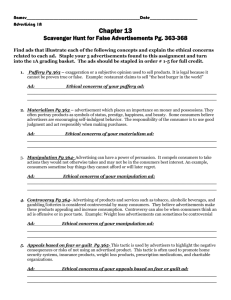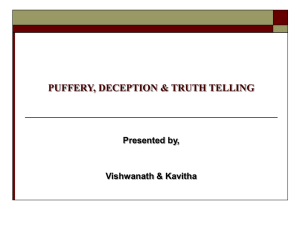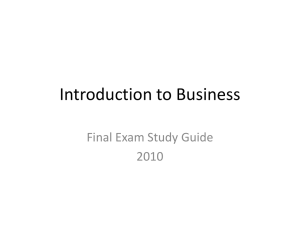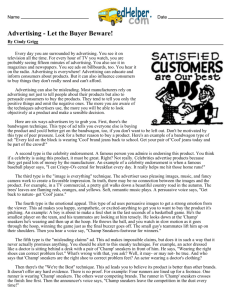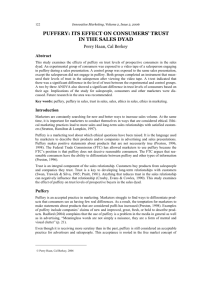Does puffery deceive in Latin America?
advertisement
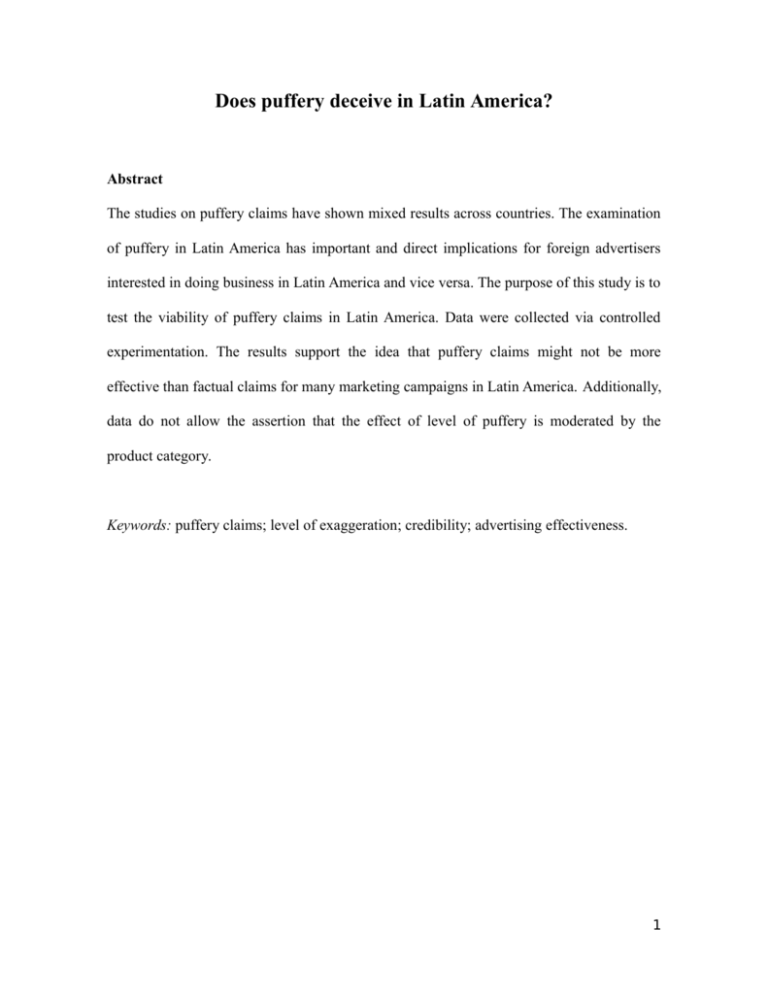
Does puffery deceive in Latin America? Abstract The studies on puffery claims have shown mixed results across countries. The examination of puffery in Latin America has important and direct implications for foreign advertisers interested in doing business in Latin America and vice versa. The purpose of this study is to test the viability of puffery claims in Latin America. Data were collected via controlled experimentation. The results support the idea that puffery claims might not be more effective than factual claims for many marketing campaigns in Latin America. Additionally, data do not allow the assertion that the effect of level of puffery is moderated by the product category. Keywords: puffery claims; level of exaggeration; credibility; advertising effectiveness. 1 1. Introduction A firm may deliver an attractive message about its product, compare the product to a similar item, list facts about the product, or make vague claims about the product which cannot be proved or disproved. This last method is known as puffery - the advertiser puffs up the product to seem like more than it is. Puffery is advertising with vague and subjective claims that can't be proven true or false. Puffery frequently includes exaggeration and the use of superlatives. The words better, best, greatest, ultimate, and finest are typically used in puffery advertisements. Examples of puffery are ‘ultimate fresh breath’, ‘made from the best stuff on earth’, ‘best tires in the world’, and ‘world's best dad’. Puffery is legal even though a thin line often exists between puffery and deception, which is illegal. Consequently, it is important to empirically study consumer perception and evaluation of puffery claims, and whether this marketing method results in deception. The studies on puffery claims have shown mixed results across countries. In the U.S. and China, studies have demonstrated that puffery claims are not more effective than factual claims (Rotfeld and Rotzoll, 1981; Haan and Berkey, 2002; Gao and Scorpio, 2011; Gao et al., 2012). In contrast, studies in Australia and Mexico have demonstrated that puffery claims are more effective than factual claims (Cowley, 2006; Jimenez et al., 2013). According to Jimenez et al. (2013), Latin American consumers are much less familiar with the use of puffery claims and thus may be more sensitive to it relative to factual claims. Consumers’ knowledge of persuasion is developmentally contingent; in other words, as people learn more about persuasion agents and their tactics, the effects of certain actions by persuasion agents (e.g. advertisers using puffery claims) on consumers’ attitudes and behaviors tend to change. This is to say that consumers who vary in their knowledge about a particular persuasion tactic (e.g. consumers who have experienced puffery claims for a 2 number of years, in contrast to those for whom the practice is unfamiliar) may interpret the same persuasion attempt differently and therefore respond to it differently (Friestad and Wright, 1994; Manzur et al., 2012). Does it then make sense for advertisers to target Latin American consumers by using puffery claims in advertisements? Puffery in advertising is permitted in most Latin American countries unless the advertised message is degradatory of the trademark, or constitutes an attempt to benefit from the notoriety of another firm or trademark (Bellingall, 2010). Marketing is an understudied area in Latin America (Fastoso and Whitelock, 2011), and the field of puffery in advertising is no exception. Too little is known about the potential of puffery claims in Latin America because only one study in the region address puffery claims (Jimenez et al., 2013). Consequently, the purpose of this study is to test the viability of puffery claims in Latin America. This study uses a Chilean sample to address this question. In this sense, Chile offers an ideal context in which to understand the potential of puffery claims in Latin America because Chile has Hofstede's scores close to the average for Latin America (Hofstede, 2001). 2. Conceptual Framework Puffery is characterized by exaggeration. Advertisers use exaggeration to get consumer attention and preference. Regulators (e.g., FTC) have allowed advertisers to use puffery because regulators believe that puffery does not deceive consumers. Regulators argue that consumers have the ability to differentiate between puffery and other types of information. Regulators allow advertisers to use wildly exaggerated or vague claims for a product or service because they believe that nobody could possibly treat the claims seriously or be misled by them. Regulators have taken the position that consumers recognize that puffery 3 lacks credibility, even though very little empirical evidence has been presented to support this assumption (Cowley, 2006). Consequently, for an advertising claim to be considered puffery and not false advertising, the average consumer must be able to see easily that the claim is an exaggeration. An advertiser may claim that its beer is the best beer in the world. No one can prove the beer is really the best, but no one can prove it is not. However, if the advertiser says that its beer contains ingredients that help to prevent cancer that is something science could prove or disprove. Trying to persuade someone that a beer brand prevents cancer would be a false claim. Consequently, a big distinction between puffery and false advertising is that puffery is subjective while false advertising consists of objective statements. It is often argued that puffery by advertisers is only useful to the seller if it successfully dupes a credulous buyer (Hoffman, 2006). Two explanations are offered for the deception. First, consumers believe the claims (Kamins and Marks, 1987; Rotfeld and Rotzoll, 1980; Shimp and Preston, 1981). Second, consumers process the puffery claims as though they were fact and generate inferences on the basis of those facts (Holbrook, 1978; Shimp and Preston, 1981; Wyckham, 1987). Consumers can be more tolerant of advertising exaggeration and less inclined to counter argue than is the case with other message forms (Shimp and Preston, 1981). Additionally, puffery claims can increase personal relevance to more consumers (e.g., users of other brands in the product category) and openly motivate them to generate points of comparison (Walker et al., 1986; Manning et al., 2001). However, consumers may speculate about the advertiser’s motives behind the puffery claims. The more claims the advertiser makes about the superiority of the sponsor brand over competing brands (e.g., ‘best tires in the world’), the more the audience thinks that the claims are attributable to 4 desperation in the face of extreme competitive pressures. This negative impact could leads to a drop in overall consumer attitude (Chow and Luk, 2006). Consumers can identify puffery claims as not credible. Consequently, consumers will not incorporate a puffery claim into their evaluations or beliefs because they understand that the puffery is a ‘wild’ exaggeration. Puffery claims could be ineffective across countries, given the underlying assumption that puffery claims distinctively affect consumers’ cognitive and/or affective activities. However, the studies on puffery claims have shown mixed results across countries. In the U.S. and China, studies have demonstrated that puffery claims are not more effective than factual claims (Rotfeld and Rotzoll, 1981; Haan and Berkey, 2002; Gao and Scorpio, 2011; Gao et al., 2012). In the U.S., Rotfeld and Rotzoll (1981) found that consumers are no less likely to believe puffery claims than they are claims based on verifiable facts. In the U.S., Haan and Berkey (2002) tested consumers' perceptions of the believability of puffery in advertising. Subjects were asked to rate how believable they found examples of each of the six forms of puffery. The results of a one-way analysis of variance showed little difference between consumers' levels of believability across the levels of puffery. In the U.S., Gao and Scorpio (2011) found that fact-based claims increased perceptions of ad truthfulness, and perceptions of ad truthfulness decreased when the consumer was exposed to puffery in an ad and also in a competitor’s ad. Gao et al. (2012), investigating the China-U.S. differences, found that puffery had very limited effects on the participants' brand attitude and purchase intent, and the Chinese consistently reported higher purchase intent than the Americans. In contrast, studies in Australia and Mexico have demonstrated that puffery claims are more effective than factual claims (Cowley, 2006; Jimenez et al., 2013). In Australia, Cowley (2006) shows that even though 5 consumers can identify a puffed claim as less credible, they still rated the brand more favorably than brands associated with a factual claim. Jimenez et al. (2013) show that Mexican consumers are more susceptible to puffery claims than factual claims. Additionally, the influence of culture is particularly important in advertising because communication patterns are closely linked to cultural norms (Hong et al., 1987). There may well be cultural factors that cause puffery in advertising to be seen as less credible and false, which therefore mitigates, rather than increases its effectiveness. For example, in his scale of six to 91, Hofstede (2001) reported that Latin American countries are highly collectivist cultures with low individualism scores (Argentina 46, Brazil 38, Chile 23, Colombia 13, Costa Rica 15, Ecuador 8, El Salvador 19, Guatemala 6, Mexico 30, Panama 11, Peru 16, Uruguay 36, Venezuela 12). The individualism-collectivism dimension is related to context. Low-context communication, which involves the use of explicit and direct messages, is predominant in individualistic cultures (e.g., Australia, the U.S.), whereas high-context communication, which involves the use of implicit and indirect messages (e.g., puffery claims), is predominant in collectivist cultures (e.g., China, Latin American countries) (Hall, 1976; Hofstede, 2001). In a high-context culture, many things are left unsaid, letting the culture explain. Words and word choice become very important in high-context communication, since a few words can communicate a complex message very effectively, while in a low-context culture, the communicator needs to be much more explicit and the value of a single word is less important (Hofstede, 2001). In order to test the viability of puffery claims in Latin America, two hypotheses are proposed: 6 H1. Consumers in Latin America are able to identify puffery claims as less credible than factual claims. H2. The level of puffery has no effect on attribute beliefs and overall evaluation in Latin America. Jimenez et al. (2013) only included puffery claims in the context of one particular product category. Consumers develop different levels of involvement through product categories. Consequently, consumers may concentrate their attention on certain product categories (e.g., the ones they purchase more often and the ones they are more engaged to). Specifically, in some product categories the consumers may want more information or to involve themselves more affectively (Chandrashekaran and Grewal, 2003; Hidalgo et al., 2008; Petty et al., 1983). Thus, it is possible that reactions to puffery claims in advertisements will vary across product categories. Hence: H3. In Latin America, the effect of level of puffery is moderated by the product category. 3. Research Design Data were collected via controlled experimentation. The design of the study was 3×3. The level of puffery was a between subject factor with three levels: a factual claim (no puffery), a ‘the very best’ claim (low puffery), and a ‘the ultimate’ claim (high puffery). Following Cowley (2006), the two puffery levels were taken from Preston (1996; 1998), who identified ‘the very best’ and ‘the ultimate’ as two of six levels of puffery. Following 7 Cowley (2006), the product category was a between subject factor with three product categories: restaurant, bar, and bus company. 3.1. Sample 429 undergraduate students at a Chilean university participated in the study. Participants’ ages ranged from 18 to 29, with an average of 21. Student samples have been widely used in advertising research (e.g., Cowley, 2006; Choi and Miracle, 2004; Jimenez et al., 2013; Manzur et al., 2012; Pillai and Goldsmith, 2008; White Nye et al., 2008; Yagci et al., 2009). Previous studies have asserted that the use of homogeneous convenience samples improve the internal validity of experimental results (Calder et al., 1981; Cook and Campbell, 1975). Also, a student sample was appropriate for the present experiment because undergraduate students are a major target market for a large number of product categories (e.g., audio systems, banking, bars, bus companies, laptop computers, mobile phones, restaurants, soft drinks). In Chile, marketers of these products have conducted promotional campaigns aimed directly at this market segment. 3.2. Stimuli development Following Cowley (2006), all of the advertisements presented hypothetical brands. The advertisement for the Alternative Bar claimed the bar was ‘the ultimate club experience’, ‘the very best club in Santiago’, or the factual claim of ‘music in the city’. The advertisement included a photo of the interior of the bar with a view of the stage with musical equipment to ensure that the participant knew the factual claim was factual. The advertisement for the Harbor Bistro claimed the restaurant was ‘the ultimate dining experience’, ‘the very best restaurant in Valparaiso’, or the factual claim of ‘dining with a 8 harbor view’. The advertisement included a photo of the interior of the restaurant with a view of the harbor; this ensured that participants could identify the factual claim as factual. The advertisement for Sobre Ruedas claimed the bus company was ‘the ultimate travel experience’, ‘the very best bus company in Southern Chile’, or the factual claim of ‘travel in premium seats’. The advertisement included a photo of the interior of the bus with a view of the premium seats. 3.3. Measures To ensure the reliability and validity of each construct, all of the measurements were collected from Cowley (2006). All materials were translated into Spanish using a double translation procedure, which has been proved as one of the best ways to provide validity to this process (McGorry, 2000). Directly after viewing the advertisements, participants were asked to provide a credibility rating for the advertisement. Participants used a 10 point scale anchored with ‘not at all credible’ (0) to ‘very credible’ (9). After rating the credibility of the ad, the participants were asked to predict the probability of receiving good service, and whether they believed the restaurant/bar/bus company would be expensive. Participants used a 10 point scale anchored with ‘not at all likely’ (0) to ‘very likely’ (9). Price information was not available. Participants had to infer the expense involved with each product. Finally, participants were asked for an overall evaluation of the restaurant/bar/bus company on a 10 point scale anchored with ‘not at all good’ (0) to ‘very good’ (9). 3.4. Procedure Participants were directed to an online survey that randomly assigned them to view one of nine advertisements. For each product category, one third of the participants saw a factual 9 claim (no puffery), one third saw a slightly exaggerated claim (low puffery), and one third saw a highly exaggerated claim (high puffery). Then, participants answered the questionnaire. 4. Results The analysis of the means for each of the nine treatments is presented in Table 1, and the means of the factors are presented in Table 2. Analysis of variance (ANOVA) has previously been used by other researchers in advertising research (e.g., Cowley, 2006; Manning et al., 2001; Manzur et al., 2012; Pillai and Goldsmith, 2008; White Nye et al., 2008; Yagci et al., 2009). Consequently, ANOVAs were calculated for credibility, expense, service, and evaluation. The ANOVAs for each variable are presented in Table 3. Finally, Table 4 presents the Eta2, which reflects the percentage of dependent variable variance explained by the independent variable in the sample data. << Table 1 here >> << Table 2 here >> H1 is supported by verifying that the level of puffery in the advertisement negatively influences the credibility of the advertisement (p-value < .01). Specifically, the results suggest that the advertisement is more credible with factual claims (6.62) than with low (5.85) or high (6.02) puffery claims. The results suggest that consumers in Latin America are able to identify exaggerated claims as less credible than factual claims. H2 is supported because it is not possible to show that the level of puffery in the advertisement has an influence on expense, service, and overall evaluation (p-value > .05). 10 The attribute beliefs (good service, being expensive) did not vary with puffery level. The null effect for the level of puffery is interesting because it indicates that an evaluation based on a factual claim is held as confidently as an evaluation based on an exaggerated claim. The main effect of product category was not of theoretical or practical interest, so the focus was on the interaction, which tested the hypothesis that the effectiveness of level of puffery varied by product category. H3 is not supported because data do not allow the assertion that the effect of level of puffery is moderated by the product category (p-value > . 05). << Table 3 here >> << Table 4 here >> 5. Discussion In general terms, the results of this study suggest that there are no significant differences between the puffery and factual claims in Latin America. Additionally, data do not allow the assertion that the effect of level of puffery is moderated by the product category. The finding that the advertisement is less credible with puffery claims than with factual claims is consistent with prior research carried out in the U.S. (Gao and Scorpio, 2011) and Australia (Cowley, 2006). However, the finding that the level of puffery has no effect on attributes beliefs and overall evaluation in Chile is not consistent with prior research carried out in Mexico (Jimenez et al., 2013). Practitioners in several countries have preferred puffery claims as a convenient and useful technique, but there are still decisions to be made in regards to which type of claim might be most effective in a given country. While experimental research is not sufficient to establish the generalized non-superiority of 11 puffery claims in Latin America, the results support that puffery claims are not more effective than factual claims, at least for many marketing campaigns and product categories in the region. For foreign advertisers attempting to tap the growing Latin American market, the results suggest that caution should be exercised when considering standardizing puffery advertisements that have been successfully developed for other markets. In most Latin American countries, advertising is self-regulated by private organizations: the CONARP in Argentina and Uruguay, CONAR in Brazil, Bolivia, Argentina, Chile, and Paraguay, etc. These private organisms perform two primary functions: they receive complaints about advertisements (corrective function) and publicize the advertising codes of ethics and jurisprudence (orienting function) (Manzur et al., 2012). As a consequence, this research is an important contribution for this type of organizations, as well as for instructors and professionals. In Latin America, the use of puffery claims can significantly increase the legal problems associated to marketing campaigns. However, the results presented in this study suggest that puffery claims could not produce a more favorable customer response in Latin America. Moreover, puffery claims presents lower message credibility, which further decreases advertisers’ incentives to use this type of claims in Latin America. Clearly this is an exploratory study, and a number of other topics are worth exploring in the future. First, not all individuals within a culture are identical. Indeed, there is substantial variation within a culture as well as considerable overlap among different cultures. Individual differences should be incorporated into future research, as should enduring consumer involvement, need for cognition, consumer knowledge, consumer expertise, brand loyalty, smart shopper self-perception, among others. 12 Second, although the use of a student sample was appropriate for this study, future studies should also use samples of consumers who are in the target markets for many other product categories. Such studies could increase the generalizability of the results as well as its applicability to advertising public policy and advertising management in Latin America. Third, the experiment should be replicated with other advertising media, such as television or radio, which would help examine the extent to which the results are generalizable to other media vehicles. Additionally, nine advertisements are certainly insufficient to produce a definitive set of conclusions. Also, the brands used in this study were hypothetical. The participants had no knowledge of these brands. The effect of puffery on established brands and the process by which a claim for a well-known brand is processed may be different than the process investigated in this study. Consequently, the experiment should be replicated with real brand names, although the use of real brands has some weaknesses. Finally, possible differences between countries makes it essential to develop studies that measure, compare, and analyze the different levels of acceptance of puffery claims among countries and their possible causes. This article attempts to encourage similar research in Latin America and other regions that confirms or refutes the results presented in this work. 13 References Alba JW, Hutchinson JW. Knowledge calibration: what consumers know and what they think they know. Journal of Consumer Research 2000; 27 (2):123–56. Begg IM, Anas A, Farinacci S. Dissociation of processes in belief: Source recollection, statement familiarity, and the illusion of truth. Journal of Experimental Psychology: General 1992;121(4):446–58. Bellingall, A.J. (2010), Comparative advertising in Brazil, Intellectual Property Magazine, October 1, 27-30. Braun KA. Postexperience advertising effects on consumer memory. Journal ofConsumer Research 1999;25:319–34 [March]. Bjork RA. Theoretical implications of directed forgetting. In: Melton AW, Martin E, editors. Coding processes in human memory. New York NY: Wiley; 1972. p. 217–35. Calder, B., Phillips, L. and Tybout, A. (1981), Designing research for application, Journal of Consumer Research, 8(2), 197-207 Chandrashekaran, R. and Grewal, D. (2003), Assimilation of advertised reference prices: the moderating role of involvement, Journal of Retailing, 79(1), 53-62. 14 Choi, Y.K. and Miracle, G.E. (2004), The effectiveness of comparative advertising in Korea and the United States: a cross-cultural and individual-level analysis”, Journal of Advertising, 33(4), 75-87. Chow, C. and Luk, C. (2006), Effects of comparative advertising in high and low-cognitive elaboration conditions, Journal of Advertising, 35(2), 55-67 Cook, T. and Campbell, D. (1975), The design and conduct of experiments and quasiexperiments in field settings, in Dimmette, M. (Ed.), Handbook of Industrial and Organisational Research, Rand McNally, Chicago, IL, 223-326. Cowley E. Recognition confidence, recognition accuracy and choice. Journal of Business Research 2004;57:641–6 [June]. Cowley E, Janus E. Not necessarily better, but certainly different: A limit to the advertising misinformation effect on memory. Journal of Consumer Research 2004;31:229–35 [June]. Fastoso, F. and Whitelock, J. (2011), Why is so little marketing research on Latin America published in high quality journals and what can we do about it? Lessons from a Delphi study of authors who have succeeded, International Marketing Review, 28(4), 435-449 Feidler K, Wlahter E, Armbruster T, Fau D, Naumann U. Do you really know what you have seen? Intrusion errors and presuppositions effects on constructive memory. Journal of Experimental Social Psychology 1996; 32:428–511. 15 Friestad, M. and Wright, P. (1994), The persuasion knowledge model: how people cope with persuasion attempts, Journal of Consumer Research, 2(1), 1-31 Gardener MP, Mitchell AA, Russo JE. Chronometric analysis: An introduction and application to low involvement perception of advertisement. In: Hunt HK, editor. Advances in Consumer Research, vol. 5. Ann Arbor MI: Association for Consumer Research; 1978. p. 581–9. Gao, Z., Li, N., Scorpio, E. (2012). Perception of puffery in advertising: investigating the China-US differences, Asia Pacific Journal of Marketing and Logistics, 24(2), 179-198 Gao, Z., and Scorpio, E. (2011). Does Puffery Deceive? An Empirical Investigation, Journal of Consumer Policy, 34(2), 249-264 Gilbert DT. How mental systems believe. American Psychologist 1991;46 (2):107–19. Gilbert DT, Krull DS, Malone PS. Unbelieving the unbelievable: Some problems in the rejection of false information. Journal of Personality and Social Psychology 1990; 59(4):601–13. Gilbert DT, Tafarodi RW, Malone PS. You can't not believe everything you read. Journal of Personality and Social Psychology 1993;65(2):221–33. 16 Haan, P., and Berkey, C. (2002). A study of the believability of the forms of puffery, Journal of Marketing Communications, 8(4), 243-256 Hall, E. (1976), Beyond Culture, Doubleday, New York, NY. Hawkins SA, Hoch SJ, Meyers-Levy J. Low-involvement learning: repetition and coherence in familiarity and belief. Journal of Consumer Psychology 2001;11(1):1-11. Hidalgo, P., Manzur, E., Olavarrieta, S. and Farías, P. (2008), Customer retention and price matching: the AFPs case, Journal of Business Research, 61(6), 691-696. Hoffman, D. A. (2006), The best puffery article ever, Iowa Law Review, 91, 101-140. Hofstede, G. (2001), Culture’s Consequences: Comparing Values. Behaviors Institutions and Organizations Across Nations, 2nd ed., Sage Publications Inc, Thousand Oaks, CA. Holbrook MB. Beyond attitude structure: toward the informational determinants of attitude. Journal of Marketing Research 1978;15(4):545–56. Hong, J.W., Muderrisoglu, A. and Zinkhan, G. (1987), Cultural differences in advertising expression: a comparative content analysis of Japanese and US magazine advertising”, Journal of Advertising, 16(1), 55-62. 17 Jimenez, F., Hadjimarcou, J., Barua, M., and Michie, D. (2013), A cross-national and crossgenerational study of consumer acculturation to advertising appeals, International Marketing Review, 30(5), 418-439 Kamins MA, Marks LJ. Advertising puffery: the impact of using two-sided claims on product attitude and purchase intention. Journal of Advertising 1987;16(4):6-15. Manning, K., Miniard, P., Barone, M. and Randall, R. (2001), Understanding the mental representation created by comparative advertising, Journal of Advertising, 30(2), 27-39. Manzur, E., Uribe, R., Hidalgo, P., Olavarrieta, S., and Farías, P. (2012), Comparative Advertising Effectiveness in Latin America: Evidence from Chile, International Marketing Review, 29(3), 277-298 Mayo R, Schul Y, Burnstein E. “I am not guilty” vs “I am innocent”: successful negation may depend on the schema used for its encoding. Journal of Experimental Social Psychology 2004;40:433–49. McGorry, S.Y. (2000), Measurement in a cross-cultural environment: survey translation issues, Qualitative Market Research: An International Journal, 3(2), 74-81. Olson JC, Dover PA. Cognitive effects of deceptive advertising. Journal of Marketing Research 1978;15(1):29–38. 18 Petty, R., Cacioppo, J. and Schumann, D. (1983), Central and peripheral routes to advertising effectiveness: the moderating role of involvement”, Journal of Consumer Research, 10(2), 135-146. Petty RE, Tormala ZL, Rucker DD. Resisting persuasion by counterarguing: an attitude strength perspective. In: Jost JT, Banaji MR, Prentice DA, editors. Perspectivism in social psychology: the yin and yang of scientific progress, APA science series. APA decade of behavior series. Washington, DC, US: American Psychological Association; 2004. p. 37– 51. Pillai, K. and Goldsmith, R. (2008), How brand attribute typicality and consumer commitment moderate the influence of comparative advertising, Journal of Business Research, 61(9), 933-941. Preston IL. The great American blowup: puffery in advertising and selling. Madison WI: The University of Wisconsin Press; 1996. Preston IL. Puffery and other ‘loophole’ claims: how the law's ‘don't ask, don't tell’ policy condones fraudulent falsity in advertising. Journal of Law and Commerce 1998;1:49-114. Rotfeld HJ, Rotzoll KB. Is advertising puffery believed? Journal of Advertising 1980;9(3):16–20. 19 Rotfeld HJ, Rotzoll KB. Puffery vs. Fact Claims—Really Different? Current Issues and Research in Advertising 1981; 4(1): 85-103 Rotfeld HJ, Preston IL. The potential impact of research on advertising law. Journal of Advertising Research 1981;21(2):9-17. Schul Y, Burnstein E. When discounting fails: conditions under which individuals use discredited information in making a judgement. Journal of Personality and Social Psychology 1985;49:894–903. Shimp TA. Do incomplete comparisons mislead? Journal of Advertising Research 1978;18:21–8 [December]. Shimp TA, Preston IL. Deceptive and nondeceptive consequences of evaluative advertising. Journal of Marketing 1981;45(1):22–32. Walker, B., Swasy, J. and Rethans, A. (1986), The impact of comparative advertising on perception formation in new product introductions”, Advances in Consumer Research, 13(1), 121-125 White Nye, C., Roth, M. and Shimp, T. (2008), Comparative advertising in markets where brands and comparative advertising are novel, Journal of International Business Studies, 39(5), 851-863 20 Wyckham RG. Implied superiority claims: parody parading as superiority. Proceedings of the 12th International Research Seminar in Marketing, La Londe Les Maures 1985:360–87. Wyckham RG. Implied superiority claims. Journal of Advertising Research 1987;27(1):54– 63. Wyer RS, Budesheim TL. Person memory and judgments: the impact of information that one is told to disregard. Journal of Personality and Social Psychology 1987;53:14–29. Yagci, M., Biswas, A. and Dutta, S. (2009), Effects of comparative advertising format on consumer responses: the moderating effects of brand image and attribute relevance, Journal of Business Research, 62(8), 768-774 21 Table 1. Means Credibilit Restaurant No Low High 6.40 5.57 5.89 y Expense Service Evaluatio 7.47 6.26 5.81 6.94 5.60 5.89 7.36 5.96 6.00 No 7.13 Bar Low 6.05 High 6.83 Bus company No Low High 6.23 5.92 5.30 6.85 6.72 6.75 7.23 6.21 6.23 7.06 6.83 7.06 6.72 6.36 6.19 5.77 6.11 5.81 5.93 5.35 5.23 n 22 Table 2. Mean of factors Level of puffery No Low High Product category Restauran Bar Bus t compan Credibilit 6.62 a 5.85 b 6.02 5.94 6.71 y 5.84b y Expense Service Evaluatio 6.99 6.46 6.29 6.59 5.97 5.97 6.83 6.06 6.12 7.25a 5.93b 5.91b 7.03a 6.60a 6.70a 6.13b 5.97b 5.76b b b a n Notes: Comparing across columns, means with different superscript differ at p < 5% (Tukey's HSD). Table 3. ANOVAs (F-values) Level of puffery Product Level of puffery x 23 (main effect) category Product category (main (interaction effect) 1.394 1.436 1.881 2.337 Credibility Expense 4.993** 1.063 effect) 6.890** 10.918* Service Evaluation 2.432 .770 * 5.246** 10.287* * Notes: Design: Intercept + Level of puffery + Product category + Level of puffery x Product category. *p-value < 5%, **p-value < 1% (all intercepts showed statistical significance) Table 4. Eta2 Level of Product Level of puffery x puffery category Product category (main effect) (main (interaction effect) 24 Credibility Expense Service Evaluation .023 .005 .011 .004 effect) .032 .049 .024 .047 .013 .012 .018 .022 Notes: Design: Intercept + Level of puffery + Product category + Level of puffery x Product category. Eta2 reflects the percentage of dependent variable variance explained by the independent variable in the sample data. 25
